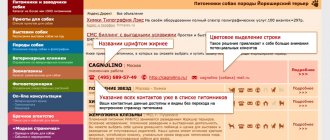During the period of fetal formation in dogs, there is a strong load on the organs, in particular the heart and respiratory organs. The kidneys and liver begin to work more actively to remove all harmful substances from the body. That is why the owner must provide comfortable conditions for the pregnant dog.
General description of the condition and duration
On average, a dog's pregnancy lasts 2 months (58 to 72 days). To calculate a dog’s pregnancy by day, you should take into account its age and the specifics of the body. A woman in labor may give birth prematurely if she has any injuries or illnesses.
A pregnant dog requires special conditions
Also, the gestation period is affected by its weight; if the dog is obese or exhausted, then problems may arise with childbirth. In this case, it is recommended to seek help from a veterinarian, as the pet may require surgical intervention during childbirth.
If the dog is first-time, then the owner should treat its first birth with greater responsibility. It is necessary to prepare for the first conception several months in advance: put your pet’s health in order, choose a suitable diet for him. In addition, you should visit a veterinarian, get the necessary vaccinations and check the animal for fleas, lice, worms and ticks.
For your information! Signs that the dog has become pregnant after mating appear only after 2-3 weeks. In females, the nipples become slightly swollen and pink, and the belly becomes more rounded.
Long-awaited event
Already in the second month of a dog’s pregnancy, the owner may notice faint movements of the puppies in her stomach. He must remember the exact date of mating in order to then calculate in detail the dog’s pregnancy by day.
How do I know if my dog has more puppies?
If you don't know how many puppies your dog is expecting, you may not be sure she's finished pregnant. There are several ways to check if she has any more puppies:
- Gently press on the outside of her belly to see if you can feel any puppies inside the womb.
- Check for placenta as there should be one for each puppy outside of the mother.
- If she pushes and strains for more than 60 minutes, it may mean she still has a puppy inside her.
Your dog's pregnancy is a very exciting time and hopefully it will go smoothly. It is important to have the support of a veterinarian to do tests, check the puppies and make sure everything is fine before delivery. However, keep in mind that not all pregnant dogs will show pup movements, so don't be alarmed if they aren't as visible as you'd hoped.
Author : Mark Aaron.
Detailed calendar for a pregnant dog by week
After mating, the process of fertilization begins, which lasts several days, and if it is successful, the process of embryo development begins. The body of each animal is individual, but basically the course of pregnancy in dogs is the same.
First week (0-7 days)
In the first days after successful mating, the animal’s egg is released from the ovaries, and sperm move toward it. Then the sperm and egg unite and the formation of a zygote begins. Next, the zygotes are sent to the uterus and are covered with embryonic membranes.
Second week (7-14 days)
The resulting embryos begin to attach to the walls of the uterus. Their size reaches approximately 0.5 mm. The placenta is forming. At this time, the dog’s well-being and appearance change slightly. The hair begins to fall out in places, particularly in the area around the nipples. The nipples swell and their color becomes pinker and richer.
Note! The expectant mother becomes more sensitive to smells and tastes. She may become more emotional as her perception of the world around her changes slightly. Therefore, the owner needs to protect the woman in labor from negative influences.
Location of puppies in a dog’s stomach: diagram
You will also have to slightly change the diet and the time you walk your dog. It is forbidden to overexert her during walks, train her, vaccinate her, or use insect repellents.
Third week (14-21 days)
The fetus begins to actively develop, during this period the skull, body, spine, nervous system and internal organs are formed. During this week, the dog’s mood and well-being deteriorate. She becomes less active, may refuse her usual food, and does not want to play or go for walks.
You should reduce the intensity of your walks; you shouldn’t strain her with intense training; quiet walks several times a day will do. During this period, the fetus size is approximately 5 mm, and the heart begins to develop.
Fourth week (21-28 days)
The fetus grows to 1 cm on day 21. A pregnant animal often vomits. Puppies begin to put a lot of pressure on the dog's stomach, so you should reduce the portion of food, but increase the amount of it taken. This week it is not recommended to play outdoor games with your pet or run. This can harm both the puppies and the mother in labor.
The size of the fruit reaches one and a half centimeters. The external organs of the head are formed. When palpating, you can feel the puppies and their movements.
For your information! On day 25, teeth and paws, both front and rear, begin to grow.
Fifth week (28-35 days)
The bones and teeth of puppies are filled with calcium, and a palate is formed in the oral cavity. Whiskers form near the nose, chin and eyebrows. During this period, active strengthening of bones and limbs occurs. The fruit size reaches 2.7 cm.
In the fifth week, the dog's belly grows significantly. The animal’s appetite also increases, as a result of which the portion of food needs to be increased. The use of any medications is not recommended, as this can lead to disturbances in the development of puppies.
Important! From the beginning to the end of pregnancy, the dog should be observed by a veterinarian.
It is advisable to have a specialist monitor your dog’s pregnancy.
Sixth week (35-42 days)
By day 35, the puppy’s body is almost fully formed. Bones become stronger and grow, and fur appears.
Seventh week (42-49 days)
In the seventh week, the fetus reaches 7 cm, and sexual characteristics are formed. Bones, organs and eyes are already formed at this stage. The puppies continue to grow; by day 45 their size should reach 9 cm.
Eighth week (49-57 days)
The fruits are fully formed, and this week they are actively moving. Using x-rays you can determine the number of babies.
Ninth week (57-59 days)
At this stage, tooth formation stops. The growth of the fetus reaches 15-16 cm, their body is completely covered with hair.
By day 59, the puppies are fully formed
Last weeks of pregnancy
In the last weeks of pregnancy, the dog becomes restless and constantly licks itself. Usually, closer to the expected date of birth, the female's appetite decreases or disappears. The woman in labor is inactive, milk begins to secrete from her nipples, which means that labor will soon occur.
Important! During childbirth, the dog may fall sharply and the water will begin to break. The owner must understand that at this time all tools for childbirth must be ready.
Dog pregnancy. Calendar by day.
Many breeders planning to breed their pet, or having already completed it, ask themselves: how long does a dog’s pregnancy last?
Your pet needs the attention and care of its owner. This need is especially acute during pregnancy. Dog gestation period
Stages of development of future puppies
Day of the first mating. It is better to carry out the control test after 48 hours, increasing the chances of fertilization. The bitch is either ovulating or has already occurred and the eggs have been released. It must be taken into account that fertilization can occur after mating. Healthy sperm retain the ability to fertilize for up to 7 days.
Sperm enter the fallopian tubes, which lead from the ovaries to the uterus.
Fertilization of the eggs occurs. In the first third of pregnancy, no significant changes occur in the bitch’s behavior. The feeding schedule and walking schedule do not change, there is no need to limit the dog in games and jumping. However, it is important to ensure that during the hot season, excessive activity does not lead to overheating and dehydration!
Fertilized eggs descend through the fallopian tubes into the uterus, becoming covered with the so-called “three embryonic membranes.”
The embryos reach the uterus and, with the help of villi, which are located on the outer shell, are introduced into the mucous membrane of the uterus. The outer lining and mucous membrane of the uterus form the “baby place” (placenta). The size of the embryos at this point reaches about 0.6 mm.
Having attached themselves to the walls of the uterus, the embryos continue to develop. Their size increases to 1 mm. At this time, the bitch's nipples may become slightly enlarged and pink, and the hair on her belly and around the nipples begins to thin out slightly.
The embryos begin to form the head, body, spine and central nervous system. The foundation is laid for the formation of internal organs.
The development of internal organs begins. The size of the embryos reaches 2 mm.
The development of embryos continues, their size reaches 4 mm.
The placenta is formed. From this moment it is already possible to diagnose pregnancy in a dog. On an ultrasound, the embryos themselves cannot yet be seen, but the membranes of the fruit are easy to notice. The size of the embryo reaches 5 mm, its heart begins to form.
From this day on, an ultrasound can be performed. The bitch may experience morning sickness and loss of appetite due to hormonal changes that occur. The dog may be lethargic, in a sad mood, and sometimes vomit. Gradually, you need to begin to change your feeding regimen, increasing the number of meals per day, while simultaneously reducing the size of each portion. Also during this period, some bitches may experience slight clear or egg-white discharge from the loop.
An excellent period for an ultrasound. The embryo begins to develop a liver, jaws, eyes, ears, nose, and its size is 1 cm.
The best period for an ultrasound. Embryos begin to develop teeth, spine and limbs. The size of each future puppy is 1.4 cm.
Embryos reach the size of a walnut. An experienced breeder or veterinarian can already diagnose pregnancy by palpation. From this moment on, it is necessary to limit the dog in active games and movements to avoid injury to the embryos.
The best period for ultrasound and diagnosis of pregnancy using palpation of the abdominal cavity. “Calcification” of the jaws and skull of the embryo begins, the size reaches 1.7 cm.
The process of “calcification” of the skull and jaws continues. The embryo reaches 2 cm. Calcium should be introduced into the bitch's diet.
The growth of “sensory” hairs (vibrissae) begins on the chin, eyebrows and near the nose.
The bitch is entering the second half of pregnancy. Embryos become fetuses and reach 20% of the newborn puppy's weight.
There is intensive growth of fruits, growth and strengthening of limbs and ribs. Their size is already about 2.7 cm.
Changes in the behavior of bitches are noticeable. They become quieter and more sensitive. The dog's belly begins to enlarge.
The bitch's appetite increases. By this period, the expectant mother needs to be completely switched to a diet for pregnant women with a high protein content. The total amount of food per day increases by 10%. It is necessary to feed the bitch at least 3 times a day, and reduce each portion. It is very important not to overfeed a pregnant dog, this is harmful both for itself and for the fetus.
At this stage, fruit growth accelerates. Bone growth continues and the shoulder blades “appear.” By this moment, all the main systems of the body have already been formed. Hair growth begins, and the development of primary sexual characteristics of future females and males also occurs. The size reaches almost 3.5 cm.
Growth of bones and overall body size of the fetus continues. By this day, almost all internal organs of future puppies have been formed. The bones of the spine and fingers grow. The eyes are already developed, but still closed, the size of the fetus reaches 6.5 cm.
The fetuses develop pelvic bones and continue to grow fur. The size reaches 9 cm.
The bitch begins to noticeably increase in size. She spends most of her time licking her nipples. The bitch's behavior becomes restless, she begins to look for shelter for the upcoming birth. At this time, you can begin preparing the enclosure and the breeding area for the bitch. After the place is ready, begin to accustom the bitch to it so that by the time she gives birth, she will get used to it.
The bitch's belly is greatly enlarged and individual movements of the puppies can be seen on its walls. Fetuses at this point reach 75% of their birth weight. The shape of the fruit bodies is formed, the size is about 12 cm. Sometimes at this time the bitch’s appetite may deteriorate or disappear. The total volume of the daily diet increases by 25-50% compared to the normal diet of the bitch.
Some bitches, especially those giving birth not for the first time, may already experience a few drops of milk coming out of the nipples at this time.
The bitch's belly increases even more, most of the time she rests and licks herself. Calcium should be removed from the bitch’s diet.
Puppies develop teeth, the growth of fetuses is 14-15 cm.
When you press on the nipples, milk appears.
It is necessary to begin preparing the place, equipment and medications for childbirth. From this point on, labor can begin at any time. You can determine when labor is approaching by measuring your dog’s temperature daily (morning, afternoon, evening). Its sharp decrease indicates that the dog should give birth within 24 hours.
At this point, the fruits have hair on their face, paws, tail and belly. The size reaches approximately 16 cm.
The dog usually refuses to eat 12-24 hours before giving birth, but may eat a large meal before giving birth. Everything is individual.
Approximate date of birth (dates may vary between 57-69 days). Hormonal changes occur, which leads to contractions of the uterus and the birth of puppies. At birth, a normally developed puppy is completely covered with hair, its eyes are closed. The average puppy size for large and medium-sized dog breeds is 16-22 cm. Weight is 300-600 grams. Miniature breeds have an approximate birth weight of 70-180 grams.
Source
How to calculate your dog's due date
The body of dogs of different breeds is slightly different, therefore pregnancy occurs with some differences. For example, to calculate the pregnancy of a Spitz in detail by day, you should use a special calendar. It will help you roughly calculate your due date.
Pregnancy of a toy terrier by day: table
To calculate the pregnancy of a toy terrier by day, a calendar will also help. In general, pregnancy in small breeds such as Yorkies, Chihuahuas and miniature pinschers is the same. Fetal development in large dogs, such as the German Shepherd, takes longer by a couple of days, since the puppies themselves are larger.
Thus, in this matter you should not leave everything to chance. Every day needs to be kept under control so that in the end your pet’s pregnancy ends successfully.
Finally, the necessary examinations have been completed, a suitable partner for the female has been found, and the puppies have been successfully conceived. Now your task is to carefully monitor the well-being of the expectant mother, as well as the development of the fetus.
Pregnancy in bitches lasts on average 60-65 days (9 weeks) from the moment of ovulation and fertilization. If the dog is sick, depressed, or is pregnant for more than 65 days, a caesarean section may be necessary.
Determining the exact date of pregnancy from the first day of mating is in most cases problematic. That is why it is advisable to carry out special tests to determine at what point the egg was released from the ovary into the fallopian tube.
This is explained by the fact that sperm survive several days (up to 5) in the female’s womb. They have a long development path to go through - from the egg to the formed fetus.
In order for your dog’s pregnancy to go smoothly and not be complicated by some unpleasant moments, it is very important to know how the fetus develops week by week. This is why the pregnancy calendar for dogs becomes an excellent tool for novice dog breeders.
First week (0-7 days)
In this phase, mating, fertilization occurs, and the countdown of pregnancy begins. The following point must be taken into account: ovulation does not always occur after the first mating. That is why you need to prepare for a control mating, which is carried out 48 hours after the first one.
Determining whether a female has become pregnant is problematic, so it is necessary to monitor body temperature. Sometimes an animal, just like a person, may experience morning sickness.
It is very important to monitor the dog’s health, provide it with good care and high-quality balanced feeding.
How can herpes be dangerous?
Herpes can cause many complications. Some of them are life-threatening.
- Bacterial complications. Most often, bacteria simply attach to the virus and the blisters fill with pus. If the blisters have already burst, then the ulcers become covered with pus, the pain in the lip becomes unbearable and a crust does not form.
- Herpetic stomatitis is a lesion of the oral mucosa. The disease begins with a sharp increase in temperature, salivation and sharp pain when chewing food. There are many blisters in the mouth, similar to herpes on the lips.
- Herpetic eye damage begins with pain in the eyes and lacrimation. A person cannot open his eyes due to severe pain. A dangerous condition that can result in blindness.
- Herpes of the esophagus. Occurs when herpes spreads from the lips. There are difficulties when swallowing, severe pain, refusal to eat and weight loss.
- Herpetic pneumonia and herpetic hepatitis occur in people with immunodeficiency and occur together with bacterial and fungal processes.
- Herpetic damage to the nervous system occurs in the form of meningoencephalitis and is the most severe form of herpes. It begins with a sharp headache, nausea and vomiting, high fever, movement disorders and convulsions. The disease is unfavorable.
Photo: To avoid complications, you need to start treating herpes in a timely manner.
Third week (14-21 days)
Embryos, whose size is already at least 1 centimeter, actively move towards the uterus and are evenly distributed in it. From the mother's body through the placenta, they receive nutrients, without which normal life activity is impossible. The next stage of intrauterine development begins - the organs, central nervous system, brain, spine, hind and front legs are formed in future puppies.
It is necessary to exclude the influence of external unfavorable factors on the expectant mother, as they can also affect the offspring. Vaccinations and other interventions in the female’s body are not carried out during this period.
On days 18-19, the size of the fruit reaches 2 millimeters. Embryos take on the body shape found in mammals.
On the 20th day, the size of the embryos is up to 4 millimeters.
The female may experience mood swings, loss of appetite, and swollen mammary glands. Remembering that the dog must provide nutrients not only to its body, but also to its future offspring, feed it as usual and control its appetite.
Recognizing early pregnancy in a bitch
The first signs of pregnancy can be noticed from the 14th day after mating. These signs are quite subtle and can be difficult to identify:
- Morning sickness . The dog loses its appetite. In the morning she experiences nausea. This is normal and should disappear over time.
- The mood changes. The female may experience slight apathy. She rests a lot during her walks and has begun to retire often.
- Changing nipples . Sometimes this may not be entirely obvious. If you look closely, you will notice that the nipples begin to swell slightly and change color.
- Increase in body weight . The dog's belly increases slightly. There may be a slight weight gain.
Based on the above signs, we can only assume that the dog is expecting offspring. More precisely, the veterinarian will tell you this, who will determine this using delicate palpation or ultrasound.
Fourth week (21-28 days)
A veterinarian and an experienced dog breeder can feel the fetus by palpating the abdomen. In embryos, the organs of vision develop, the muzzles take on their usual shape, and the spine becomes stronger. The fruit size is up to 1.5 centimeters in length.
In veterinary medicine, this period of pregnancy is considered the most important, since puppies are especially vulnerable to the development of abnormalities and damage. The dog must be limited in physical activity and physical activity. There is a need for nutritional correction; additional nutritional supplements are introduced into the diet.
The female's nipples become rough, and a small amount of clear fluid may be released from the vagina.
How does herpes manifest?
In medicine, it is customary to distinguish 5 stages of the development of herpes simplex: 1. The first stage occurs when blisters appear. It manifests itself as burning and itching in the lip area, and its swelling. 2. The second stage begins with the appearance of bubbles. At first small, they grow and fill with clear liquid. After a couple of days the liquid becomes cloudy. 3. The third stage of the disease is characterized by rupture of the vesicles. In place of the burst blisters, ulcers with swelling form. This stage is dangerous due to the development of complications. The person at this moment is very contagious. 4. In the fourth stage, the ulcers become covered with a dense crust. 5. At the fifth stage, the crusts dry out and fall off. The symptoms go away. The person becomes no longer contagious.
Fifth week (28-35 days)
During this phase, the amount of amniotic fluid increases, which makes it difficult to palpate the fetus in the dog’s stomach. Puppies are no longer so susceptible to developing abnormalities. They develop claws, whiskers, and genitals. At 30-32 days, the size of embryos is up to 2 centimeters, at 33-34 - 2.7 cm. Body weight is 20% of the weight of newborn puppies.
On the 33rd day, the palate tightens or completely closes. If this does not happen, the puppy is born with a pathology incompatible with life - a cleft palate.
The female gains weight, this is due to the presence of amniotic fluid and the rapid development of the fruits. The dog should receive enhanced nutrition, fractional feeding, in small portions. Under no circumstances should you give your animal medications or chemicals, as they will inevitably harm the offspring.
During this period, it is advisable to conduct an ultrasound examination to determine how the future offspring develops and whether they have any abnormalities. An ultrasound can also determine the number of puppies.
Week six (35-42 days)
The female's belly increases greatly in size, and now her pregnancy is an obvious fact for everyone. Every day it will grow. Changes also occur in the female’s body: the nipples become larger, their shade changes - it becomes darker.
During this phase, puppies begin to develop their individual characteristics. Skin pigmentation determines coat color. On days 35-39, fetal growth is 3.5 cm, by the 40th day it increases to 5 centimeters.
The number of feedings of the female increases, but if the dog wants to eat, you should not refuse it. At the same time, overfeeding and excessive weight gain should be avoided. A smart step would be to include multivitamins and special food for puppies in the menu, but only a veterinarian can say what exactly will be beneficial for your dog.
The owner can already prepare in advance the place where the dog will give birth. It should be warm and comfortable. Expectant mothers need to be gradually prepared for a cozy place, and her desire to relax in it should be encouraged.
Seventh week (42-49 days)
The puppies develop safely and quickly; at this stage they are already fully formed.
The female sheds heavily, especially in the abdominal area. This is a normal physiological phenomenon and should not cause concern. In this way, the expectant mother’s body prepares for the birth of babies.
Complementary feeding with special food for puppies can be omitted, and the female can be transferred to the usual method of feeding, but the food must be nourishing, enriched with vitamins and nutrients.
Eighth week (49-57 days)
During this period, the owner needs to be on alert, as puppies can be born at any minute. The bone tissue of puppies is already very strong, the teeth are formed, and their growth corresponds to the size of newborns. An ultrasound will accurately determine the number of fetuses.
Physical activity and stress accelerate this process, so it is necessary to surround the expectant mother with care and attention, make sure that she moves less and rests more. It is advisable for the puppies to stay in their mother's belly for a week. When the dog is lying down, you can feel the puppies to see how they move in the uterus.
The female begins to secrete colostrum from her nipples, which is a harbinger of childbirth. She worries, looks for a comfortable, quiet place for childbirth, lies most of the time, getting up only to eat and perform natural needs.
Ninth week (57-59 days)
During this phase, the puppies' muzzle, paws, tail and belly are covered with soft, light hair. The body and internal organs are entering the final stage of formation. Since the puppies are already quite large, they fill the entire body of the uterus and practically stop moving.
The dog behaves restlessly, is worried, and tries to dig holes. The owner can expect the first contractions and the pet.
The appearance of the long-awaited offspring usually occurs on the 65th day. Representatives of large breeds may give birth earlier - on the 63rd day. This is not considered an anomaly.
The owner must make sure that everything is prepared for this important process. A dog should not need for anything. The bitch avoids contacts, tries to protect herself from the outside world. There is no need to force feed, as appetite decreases before childbirth. A dog should eat when it wants it.
The approach of labor is determined by measuring temperature. The normal body temperature of an adult dog is on average 37-38.9 degrees. 12-24 hours before birth it decreases by 1-2 degrees. A characteristic sign of labor is the discharge of amniotic fluid, which is a viscous liquid of a light yellow color.
During this period, the corpus luteum ruptures and the cervix opens. Hormonal changes occurring in the body provoke increased contractions of the uterus and contractions. Puppies are born one at a time, after a certain period of time. Their bodies are covered with fur, their eyes are tightly closed.
Litter size
The number of puppies depends on the age and breed of the animal. Miniature dogs of decorative breeds give birth to only one baby, while large ones have 15 or more.
Young bitches give birth often and fruitfully. However, when they reach 4 years of age, reproductive function declines. At first, the number of puppies decreases, and in old age (after 7 years) it decreases as much as possible. The small number of babies (no more than two) is due to insufficient uterine contractions due to dystonia and the large size of the fetuses. This phenomenon is typical for all dogs, regardless of breed.
The formation of the fetus will require a lot of effort from the dog, since the long-term development of the puppies’ bones is achieved through the assistance of the animal’s body. For this reason, protracted illnesses often worsen during fetal development. There is also a significant load on the heart and respiratory organs; the kidneys and liver function at a rapid pace, removing harmful elements from the body. The article describes a dog's pregnancy day by day until the stage of birth of the offspring.
3.Diagnostics and treatment
Diagnosis of placental abruption
Diagnosing premature placental abruption in the early stages can be difficult. The doctor will ask some questions about your health and perform a series of tests. It could be an ultrasound
(helps detect about half of all cases of placental abruption),
CTG
(to assess the condition of the child and uterine contractions),
blood test for anemia
.
Treatment of placental abruption
Treatment for placental abruption depends on how severe it is, how the abruption affects the baby, and how far along you are in the pregnancy.
Minor placental abruption
if the fetus is in normal condition, it is not an absolute indication for hospitalization. Of course, your doctor will check your health and that of your baby frequently, but overall the prognosis can be very good. If premature birth begins due to a small abruption of the placenta in the early stages, doctors can stop it with medication.
For moderate or severe placental abruption,
Most likely, hospitalization will be required.
It will help avoid serious consequences. Often such placental abruption is an indication for emergency caesarean section
. If the mother has significant blood loss, a blood transfusion is required.
About our clinic Chistye Prudy metro station Medintercom page!
Duration of pregnancy in dogs
Typically, the gestation period for an animal lasts up to 62 days. However, sometimes puppies can be born starting at 58 days or much later, meaning pregnancy can last up to 72 days. The duration of gestation is influenced by the specifics of the animal’s body, age, or if the dog gives birth for the first time.
A sign of early resolution of labor, for example, on the 58th day of pregnancy in a dog can be caused by previous injuries, illness, exhaustion, excessive obesity, or a very young age of the animal. When the animal has not given birth until late (72 days), then she will need a surgical operation (cesarean section).
The first pregnancy is the most difficult test for an inexperienced dog, since it lasts much longer. The owner of a young dog does not need to rely on “nature”. The animal needs mandatory assistance, since natural instincts do not always awaken in domestic animals.
So, you should prepare for the process several months before planning conception. Preliminary preparation includes removing excess fat accumulation, selecting a healthy diet, performing the necessary medical vaccinations and timely elimination of fleas and worms.
How to tell if a dog is pregnant?
After mating, it is impossible to immediately recognize whether conception has taken place or not, since no special changes will occur. After 14 days, some females may develop a depressed mood, a decrease or complete indifference to food. This behavior is completely normal, including when the dog becomes pregnant. Starting from this period and after 30 days, the animal’s nipples swell, changing color to a bright pink hue.
However, behavior, sleep and food cravings remain unchanged. During weeks of pregnancy in dogs, the owner needs to increase the number of feedings to three feedings a day. Please note that during pregnancy, increased portions of fermented milk products and foods containing large amounts of protein should be important in the diet.
From the second month you can observe an increase in the abdomen near the ribs. 20 days before the upcoming birth, the female gains weight at a rapid pace, it is important to monitor her nutrition. When the dog is in a lying position, you can clearly see the movement of the puppies. Do not forget also about walking the dog, but without any stress, so as not to affect the development of future offspring.
False pregnancy in a dog
Failure of the reproductive system in dogs is a fairly common occurrence in the animal’s body, which must be determined as quickly as possible in order to eliminate undesirable consequences for the body. The disorder occurs in unmated females after the period of estrus, and also as a result of unsuccessful mating. As a result of such mating, the same accumulation of hormones is formed in the animal that is observed in a fertilized bitch. The key signs of false fertilization are quite similar to the symptoms of a dog’s real pregnancy week by week and look like:
- enlargement and change in color of nipples;
- discharge in the form of colostrum;
- the volume of the loop changes in size;
- loss of appetite;
- searching for a place for future offspring.
As a rule, signs of false fertilization disappear after 2 weeks. There is no need to worry about the dog’s well-being, since nothing threatens the pet’s health.
It is incredibly difficult to distinguish a false pregnancy from a real one, since there is discharge and corresponding behavior of the animal. Therefore, the main criterion is the absence of movement of the puppies in the stomach. However, the easiest way to eliminate such a pregnancy is to use modern ultrasound diagnostics.
Stages of movement of puppies in the belly of a pregnant dog
During the first 3 weeks of pregnancy (21 days), the puppies will not move. In fact, you may not even know that your dog is pregnant at this time. Potential signs of pregnancy include :
- Has her appetite decreased? Looks like she ate the food?
- Is she acting more tired and less active than usual?
- Did her nipples grow? If yes, she may be pregnant.
- Can you notice an increase in belly size? This can happen in less than 2 weeks.
How many weeks does pregnancy last in dogs?
During the first week of pregnancy, sperm move to the animal's gamete for two days for fertilization. Already on the third day, the reproductive cell moves into the paired tubular organ connecting the uterus with the abdominal cavity, and on the 4th day the process of fertilization takes place.
At the end of 7 days, as a result of the fusion of both cells, the zygote moves directly into the uterus.
There are no special modifications in the animal’s behavior, so you can walk the dog as before with the same frequency. The diet also remains unchanged at the moment. If this is your dog’s first pregnancy, do not forget to consult a veterinarian with any questions you are interested in.
In the second week, the embryos are established in the lining of the uterus and transform into the placenta, which establishes a connection between the mother’s body and the fetus. Embryos develop at this stage, not exceeding the size of a millimeter. On the 15th day, a new period of intrauterine enlargement begins: the necessary organs of the upcoming offspring are formed.
On days 16-17, embryos grow to one mm. They develop a torso, spinal column, head and central nervous system. Starting from days 18 to 20, internal organs are formed, and the size of the embryos is 4 mm. At the end of 3 weeks, the heart develops. The volume of the embryo is already 0.5 cm. From 4 to 5 weeks you need to carefully monitor the dog, since starting from day 22 it is necessary to change the feeding schedule.
The animal may vomit in the morning, so it is preferable to offer food often and in small doses. From days 23 to 32, the fruit grows to the size of a nut. At this stage, teeth, spine, upper and lower limbs develop, and the supply of calcium to all necessary parts of the body is reproduced. The period of 6-7 weeks indicates the obviousness of pregnancy, since the embryos develop rapidly and gain size up to 6.5 cm.
On the 44th day, the uterus occupies a significant portion of the abdominal cavity. At this time, it is possible to feel the offspring, but it is still difficult to establish their exact number. The final period of gestation from the 50th to the 57th day is characterized by fully developed embryos, and their size reaches about 15 cm. On the 58th day, with light pressure, milk flows out of the nipples. The time from 59, 61, 62 days of pregnancy in a dog is considered to be approaching childbirth, so the necessary medications should be on hand at home. The animal's body temperature should be measured periodically.
Remember that the day before giving birth the temperature drops slightly. As a rule, on the 63rd day the waters recede and the gradual expansion of the uterus begins. The next day, hormonal changes appear and contractions begin. Puppies do not appear one after another, but with slight intervals. A dog's pregnancy period lasts approximately nine weeks. Thus, you found out how many weeks pregnancy lasts in dogs.
Information about the process of fertilization in an animal is presented in the pregnancy calendar by day:
- 1 day. Fertilization can occur after mating or after a couple of days;
- Day 2. Repeated mating is carried out, the live ones move to the formed eggs;
- Day 3. Sperm enter the uterine tubes;
- Day 4 Fertilization takes place;
- 5 - 11 days. The eggs descend into the uterus;
- 12-14 days. Embryos are introduced into the uterus, and the embryos have a size of up to 0.6 mm;
- Day 15 The period of formation of vitally important organizations for the upcoming spree is coming;
- Day 16 The volume of embryos increases to 1 millimeter;
- Day 17 The development of the head, torso, spinal column and central nervous system begins;
- 18-19 days. Formation of internal organs, the volume of the primordia reaches 2 mm;
- 20 days. The dimensions of the embryo are 4 mm;
- 21 day. The period of placenta formation. The size of the embryo is 5 mm, and the formation of the heart begins;
- On day 22 it is possible to perform ultrasound;
- 23 - 24 days. Formation of the liver, jaw, organs of vision, smell, and hearing. The size of the embryo reaches cm;
- 25-29 days. Formation of teeth and limbs. The volume of the upcoming offspring is 1.4 cm -1.7 cm;
- Day 30 Embryo 2 cm;
- 31 days. Hair growth stage;
- Day 32 Beginning of the 2nd half of pregnancy;
- Day 33 Rapid increase in fruits up to 2.7 cm;
- Day 34 Changing the animal's behavior to a calm state;
- Day 35 Appetite increases;
- Day 36 The dimensions of the fruit reach 3.5 cm;
- 37 - 40 days. The increase in bones and body size continues;
- By day 40, organs finish forming, and the fruits are 6.5 cm;
- 41 - 44 days. The period when the offspring can be felt;
- 45-47 days. Fruit volume 9 cm;
- 48-49 days. Significant growth of the abdomen in volume;
- Day 50 The abdomen is very enlarged, the movement of the chicks is noticeable, and the size is 12 cm;
- 51 days. The release of milk droplets can be monitored;
- 52-54 days. The dog rests and licks itself;
- 55-57 days. Fruit increase up to 15 cm;
- Day 58 Milk secretion;
- Day 59 Preparing medications as labor may begin soon;
- 60-62 days. Volume reaches up to 16 cm;
- Day 63. The day before giving birth, the animal turns away from food, t decreases by at least a degree, and the cervix opens;
- Day 64 Period of possible birth of puppies. Changes occur at the hormonal level, which contribute to increased contractions of the uterus, with the appearance of contractions. The puppy appears at irregular intervals. The born puppy reaches from 16 to 22 cm;
- Day 65 The emerging puppy is cleared of the placenta, and the baby’s weight ranges from 300 to 600 grams.
What the owner of a breeding bitch needs to know
Home → Owners → What the owner of a breeding bitch needs to know
Having mated a bitch, the owners expect that she will immediately begin to devour food in large bowls, and sigh in disappointment when the “daughter” loses her appetite after mating - “it didn’t work out...”, and stop paying attention to the bitch. And then time went by...
It has been noticed that the more embryos and future puppies are in the uterus, or the weaker the bitch’s body, in particular her liver, the stronger the toxicosis. If the bitch does not have many embryos or her body is in perfect order and can easily cope with the additional load, then the bitch may not have any toxicosis at all. Any medicinal procedure on a puppy dog is absolutely unacceptable. In case of severe toxicosis, feeding in the evening with very small portions of something fermented milk helps.
Let's say you bred a bitch on January 1, 3, 5, from the middle of this period, that is, from January 3, we will count the gestational age. The pregnancy itself lasts from 53 to 70 days, such a range is not surprising, because not only do the embryos attach to the uterus after some time, but it is also impossible to determine when this happens.
Physiologically, everything happens like this - the female has a rather short vagina, and the male has a rather long penis, so during mating, sperm is sprayed directly into the uterus, and while the dogs are standing in the castle for at least 5 minutes, some eggs can already be fertilized, if they are there and are in mature form. And when the dogs separate, the dog’s excess lubricant flows out of the bitch’s vagina, which helped create the necessary alkaline background for the sperm and helped “squirt” them as far into the uterus as possible. The only thing that the lubricant leaking from a bitch may contain is immature or overripe sperm, which are of absolutely no value, since they are defective and cannot even move.
Important procedures before mating: It would be ideal if, before mating and pregnancy, the owner read special literature or asked the head of the breed, his breeder, how the reproductive system of the bitch works approximately, and those who are disdainful of this should not have animals at all.
You shouldn’t expect that everything will “be born” by itself, “before they gave birth in holes and nothing!” You yourself don’t agree to try to give birth in a cave? If you value your bitch, you must do everything in your power, from beginning to end. Do not forget to vaccinate your dog at least 1 month before mating if the previous vaccine expires by the time of pregnancy. These may be the latest modification vaccines: 6-valent Nobivak vaccine, 5-valent Vanguard vaccine, 6-valent Hexadog vaccine, Eurican. A week before mating, you need to give the dog anthelmintic drugs, such as Drontal Plus, Febtal, Alben S, Cestal Plus.
The bitch should eat as much as she wants, and when she wants. But, of course, not porridge, but meat, cottage cheese, fruits, cheese - if you feed the bitch natural food.
After 40-45 days, the bitch’s appetite increases sharply, and again, the amount of food increases only due to protein products. Professional dog breeders generally act simpler - depending on today's requirements, dogs purchase specialized complete dry and/or wet ready-made food and do not add anything else to the food - everything the dog needs now, it has, it is only necessary to increase the supply of food as its appetite increases dogs. Excellent complete feeds are feeds such as Royal Canin, Hills, Ekanuba, Pedigree Advance, etc.
The first sign of pregnancy is toxicosis, which was described above.
The third sign is the appearance on the 35-45th day of viscous, thread-like, transparent pale green or pale cream discharge from the bitch’s loop. Having appeared, their number increases every day.
A few days before giving birth, the weight of a bitch's belly with multiple pregnancies can reach almost half the bitch's weight.
A week before giving birth, the bitch’s body temperature gradually begins to drop; in the morning it can be 38.5 (normal), in the evening 38.3. The next morning 37.9, and in the evening 38.2. So, in leaps and bounds, now up, now down, it gradually falls.
It is necessary to measure the temperature 2 times a day, in a calm dog, with a thermometer inserted into the butt for 3 minutes. If you have an electronic thermometer, it will beep when the temperature is measured. The results must be recorded. The minimum temperature for each dog is individual; moreover, it is not the same low in different pregnancies for the same dog.
The signal is a temperature drop below 37.5 degrees. On this day, you must constantly monitor the dog and be ready to help her start giving birth in the place you have chosen.
Preparations for childbirth: You should prepare in advance for childbirth: * a stack of old, clean, well-absorbent rags; * multi-colored ribbons or tags with numbers that you will tie on the neck of each puppy in turn; * a notebook where you will write down when the “plug” (a greenish-beige clot of mucus) came out and what time your water broke, the time of birth of each puppy, whether it was in the placenta, whether it was active or had to be revived, etc.
Prepare (boil for 10 minutes) a surgical forceps and blunt-tipped scissors.
| The puppy has just been born. Half of the puppy is still in the bitch's loop. It's still all in the bag. We don't wait for it to come out entirely. | The bag was completely removed. Now we need to deal with the umbilical cord. The other end of the umbilical cord may still remain in the bitch's loop, don't let that worry you. The blue circle marks the place for applying the clamp. A green stripe marks the place where the umbilical cord needs to be cut. |
If everything is normal and the puppy is born, you need to immediately break the bubble above its head with your hands, turn the puppy upside down so that the fluid flows out of the lungs and nose and blot its mouth with gauze. It’s okay if the puppy lies with the umbilical cord uncut all this time, the main thing is to let him breathe. Now we take a surgical hemostatic clamp, step back 1 cm from the puppy’s abdomen and use forceps to strongly squeeze the umbilical cord for 30 seconds, it will immediately turn white and now it can be cut off with scissors, but not from the puppy’s side, but from the side of the placenta remnants (see picture)! Now there is no need to tie the umbilical cord; after applying the clamp there will be no bleeding. We wipe the puppy dry, shake it properly, examine it from all sides for the presence of structural defects or defects, and if everything is in order, then apply it to the mother’s chest (signs that are a defective structure or defect in your breed - you need to check with your breed leader ).
We do the same with all subsequent puppies. It is imperative to record whether the puppy had a placenta (amniotic sac, “shirt”) - the number of placentas must match the number of puppies. Remains of placenta or a puppy in the uterus will lead to sepsis and possible death of the bitch.
During childbirth, the bitch must be taken outside several times to relieve herself. Don't worry, she won't give birth on the street; animals are great at stopping labor. But a full bladder prevents the uterus from contracting and pushing out puppies.
According to the latest scientific data, puppies that do not receive the attention, licking and caress of their mother grow slowly, develop slowly mentally and physically, and these losses cannot be compensated for by any efforts in the future. Is labor over?
When the dog has given birth to all the puppies, she clearly relaxes, falls asleep, and you can see that her belly has acquired a girlish size; it feels quite empty to the touch.
Oxytocin is packaged in ampoules of 1 cube and is administered intramuscularly. You cannot enter 1 cube at once, you need to enter 0.5 cubes, and only after half an hour another half a cube. In order to prevent complications after childbirth, oxytocin is administered for 2-3 days, 3 times a day, 0.5 cubes, the leftovers can be kept in the refrigerator.
This disturbance in the dog’s blood can occur at any stage of pregnancy, after childbirth, while feeding puppies, and even after they are weaned from their mother, a month after birth.
In other words, the mother’s body will give to the embryos, and then to the puppies, everything that it itself has, everything that it has accumulated in the blood, bones, and liver over the entire previous life, but the puppies will receive everything they need, even if the mother will be exhausted. Therefore, the owner’s duty is not to exhaust or ruin the dog at the first mating.
How can you help your dog even before your doctor arrives if you notice symptoms of eclampsia? Inject subcutaneously 10 cubes of 10 percent calcium gluconate, drink mixed with 1 tbsp. 15 drops of Valocordin with a spoon of water to support the work of the heart muscle and place the dog in a quiet, dark place; the puppies should be put in a warm place and you should take full care of them.
If the dog has convulsions and muscle twitching, then to all these actions add an intramuscular injection of 1-2 cc (depending on the strength of the convulsions and the weight of the dog) of one of the drugs that relaxes and relieves convulsions - Relanium, Seduxen or Tazepam. Convulsions must be relieved immediately, since during one of the convulsions the dog may stop breathing.
First aid kit for childbirth: For childbirth, just in case, you need to prepare a first aid kit, which should include the following medications:
At any stage of labor or after it, due to rupture of small or large vessels of the uterus, the bitch may begin to bleed. What urgently needs to be done before the doctor arrives?
1) Inject intramuscularly 1-3 cubes (depending on the severity of bleeding and the weight of the dog) of the hemostatic drug dicynon. 2) Place an ice pack on the dog’s stomach (keeping all puppies in a warm place heated to 39 degrees). 3) Give the bitch some sweet, cold, strong tea.
Naturally, with all these complications, it is necessary to immediately call a specialist at home, but childbirth often occurs at night, the specialist may be delayed, the nearest pharmacy will be closed, and the minutes count. So it’s better to have everything at hand, just in case, so that you can always help your pet. In principle, complications do not occur often, with careful attention and if the breed is not “extreme” the birth takes place quickly, the puppies are born strong and healthy, and bring only joy and pleasure to their mother and her human “family”.
Source
Proper care for a pregnant dog
Hygienic measures for the animal include examinations every day, cleaning the fur, and checking the skin. In the second half of gestation, a pregnant dog sometimes has mucus discharge from the birth canal. In most cases, the dog removes the discharge by licking itself. In rare cases, when the dog is still young and this is her first pregnancy, she may not do this, then you should simply clean the area with ordinary clean water. However, there is no point in cleaning the animal 2 weeks before giving birth.
When the pet has not received timely treatment with deworming drugs before mating, in this case the process must now be delayed for 14 days after the birth has been resolved. Remember that during the period of breeding dogs, it is also necessary to abandon such activities and any other medications, including flea treatment. Keep an eye on your dog so that it does not have contact with sick or stray animals.
There are times when a dog can relieve itself in an apartment. This is a fairly common occurrence during pregnancy, since the dog sometimes cannot control this process. You shouldn’t take this aggressively and take your anger out on the dog.
Indeed, in the late stages of pregnancy, the animal needs special attention and care. Try to plan and organize your upcoming birth location as quickly as possible. The site should not only be comfortable for the animal, but also free from drafts.
Also try to arrange the place so that there is free access to the dog to assist during childbirth. Gradually accustom the dog to the area so that in the future it will not look for another place to give birth. An important place in the later stages is given to walks, since spending time in the fresh air cannot be reduced.
Walking will only benefit the dog. In the first month of pregnancy, training is not contraindicated, however, starting from the second month, protect the bitch from jumping and running.
Vitamin complex
Vitamins have a beneficial effect on metabolism throughout the body. The prescribed complex of essential beneficial microelements are catalysts that promote better absorption of food. Of course, animals need a certain amount of vitamins, especially during pregnancy. Most of the vitamins enter the body from food, but not always in the required dose, which is why there is an urgent need for additional supply to the body.
During pregnancy, the pet's menu should be enriched with additional elements, which can be prescribed by the doctor if necessary. The development of puppies will require a lot of minerals and vitamins, which the dog sometimes lacks. Therefore, a good option for the healthy development of puppies is additional vitamins prescribed by a veterinarian.
In the first month after mating, veterinarians do not advise changing the pet’s menu, and the introduction of vitamins is not yet required. Ordinary habitual nutrition will be able to fully guarantee the basic needs of the body at this stage. It’s a good idea to add a few yolks per week to your dog’s diet. The menu needs to include more protein foods and lean meats, for example, beef.
After the first month of pregnancy, it is recommended to significantly increase the dosage of food and switch to feeding 3 times a day. It is necessary to add a small amount of fish oil to food, which guarantees a supply of nutrients during pregnancy. In addition, you will need to use vitamins A, B, D and E. Together with vitamin D, large amounts of Ca should be used - an important element in the formation of the skeleton of puppies and the maintenance of the mother’s body as a whole.
In cases where large offspring are expected, a special need appears for lactate and glycerophosphate. However, in addition to vitamins, you shouldn’t lose sight of simple foods. Pay attention to the benefits of dairy food, which is necessary for a pregnant bitch. They have a huge amount of calcium and phosphorus, as key elements that a dog cannot do without during the gestation process.
How does the virus become infected?
The virus can be infected in different ways: airborne droplets, contact (through shared towels, cutlery, through kissing), sexual intercourse, self-expression (when the virus from ulcers enters healthy mucous membranes and infects them). You can become infected through a blood transfusion and a child can receive the virus from the mother in utero. The incubation period (from the moment of contact until the first signs appear) is 2-14 days. A person becomes contagious as soon as sores appear on the lip, and is contagious to others until the scabs fall off .
Photo: One of the most common ways of transmitting herpes is contact.










